Are you a business owner or advertiser who is considering how to use Google Trends to gain an edge in expanding your brand?
Well, you are probably at the right place to find out your answer.
Consumers today act differently from those of a decade ago. They are more powerful than ever because they’ve got more information available to them than ever before.
This makes it difficult for marketers to come up with new approaches for connecting with consumers on a real level as well as merely getting in front of them.
Brands must demonstrate to their target consumers that they comprehend them and their interests if they want to build trust. This strategy promotes relatability and empathy and raises conversion rates.
By implementing tactics based on consumer behaviour data, businesses may embrace consumer empowerment. In this article, we’ll go through how businesses may use resources like Google Trends to pinpoint customer preferences, provide memorable (perhaps viral) content experiences, and most importantly how to use Google Trends to make money exponentially for your business.
What is Google Trends?
Google Trends is an effective and free tool that offers both long- and short-term analysis of the trendiest search phrases. It gauges the popularity of search phrases on a scale of 0 to 100, their popularity compared to other terms, geography-related data, and more.
What people look for provides a glimpse into their wants, drives, and issues. The tool may be used to display trends across individual queries, demonstrating similar topics and interests among big groups.
How to Use Google Trends? – 10 Ways to Use it for Businesses
1. Using Google Trends to Find Niches
Google Trends is a fantastic tool for identifying a rapidly growing niche, but you might think how to use Google Trends to find a niche.
Whenever you want to find out a new niche, first make sure you change your time range from ‘Past 12 months’ to ‘2004-present’ One can simply tell if the search traffic is rising or falling by doing this. You may, however, use it to get an accurate image of the seasonal shifts.
Here’s an example of a rapidly growing product in Google Trends: ‘sports shoes’.
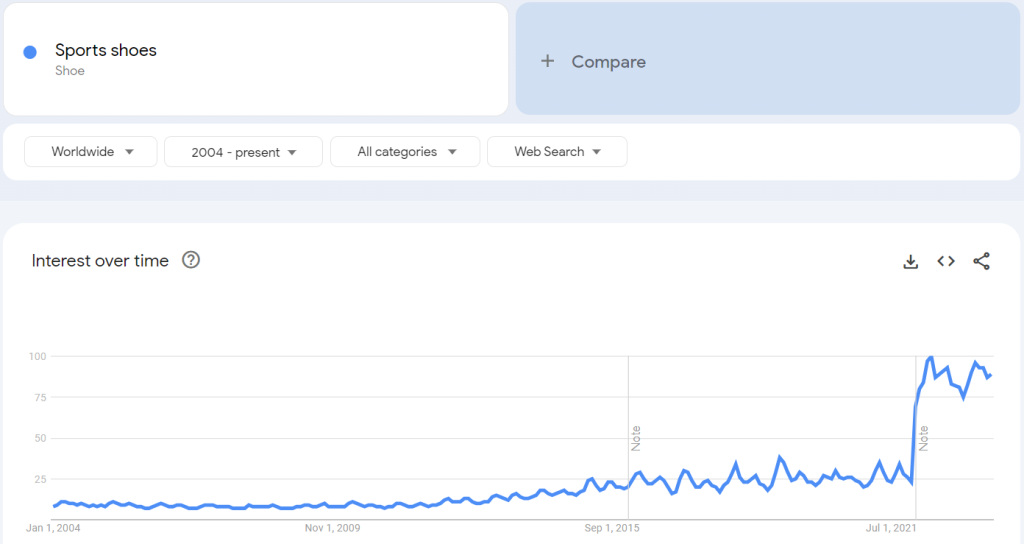
The graphic makes it very clear that there has been a dramatic spike during the past several months. May 2022 had a significant increase, which was followed by a little fall in January 2023. However, that does not imply that you cannot make money from sales. As a result, it would be important to keep an eye on this profitable item.
Here is an illustration of a Google Trends stable niche: ‘men’s footwear’.
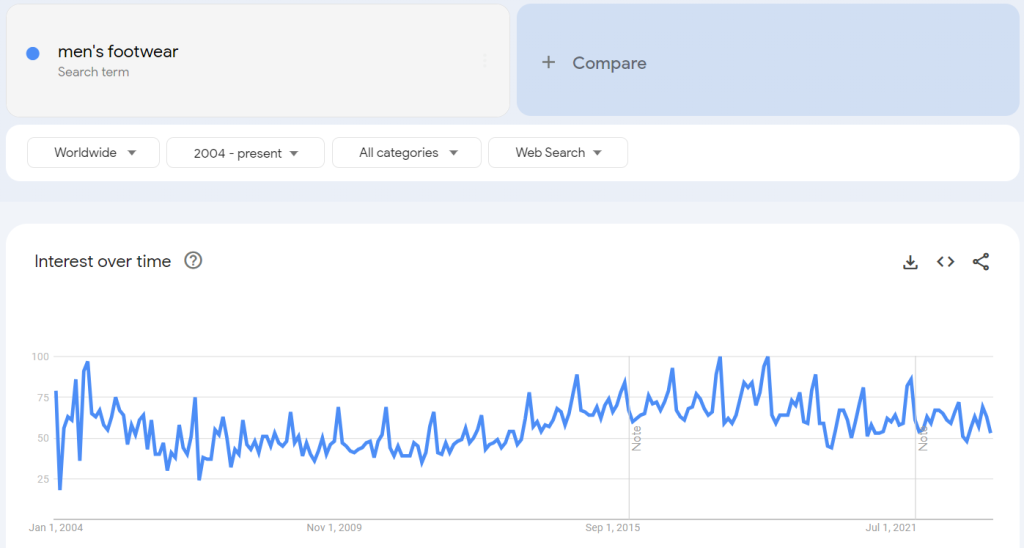
There are obvious little dips, as seen by the graph. It’s typical to see a few minor peaks or valleys over the course of several years. Google Trends, however, suggests that the market for men’s footwear tends to be more stable.
You might be wondering what the dips and rises mean. These show the seasonal search trends. From November through December, search volume increases. In January and February, it starts to decline. This isn’t to say you shouldn’t launch a men’s footwear company in January; it’s just to indicate that you could have lower website traffic then.
Ever questioned how a sudden craze might show up on Google Trends? Considering that, you may want to read this information on ‘crocodile leather shoe’.
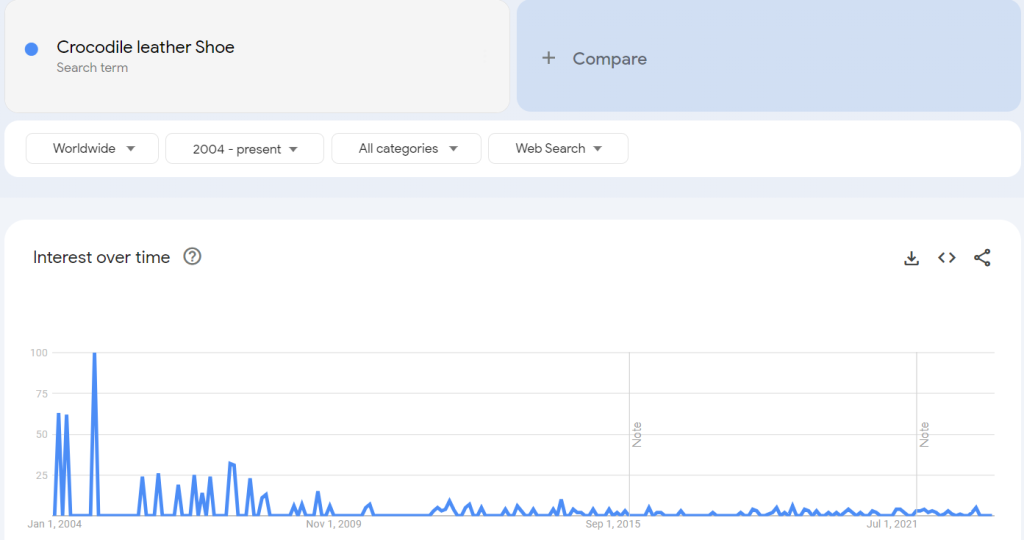
There were a lot of searches for crocodile leather shoes up until November 2004, but following the initial excitement, they drastically decreased. The sharp decline that followed the peak, however, shows that it is no longer a lucrative endeavour to consider releasing this unique type of shoe.
2. Using Google Trends to Find Relevant Product Categories
Imagine you’ve opened a specialty shop selling ‘artificial nails’. You could be considering branching out into other verticals once you’ve established your niche. Consequently, you want to sell additional product categories in your business instead of only artificial nails as you never know what customers could be interested in.
Search ‘artificial nails’ in Google Trends, then scroll down to the bottom where you’ll see ‘Related topics’.
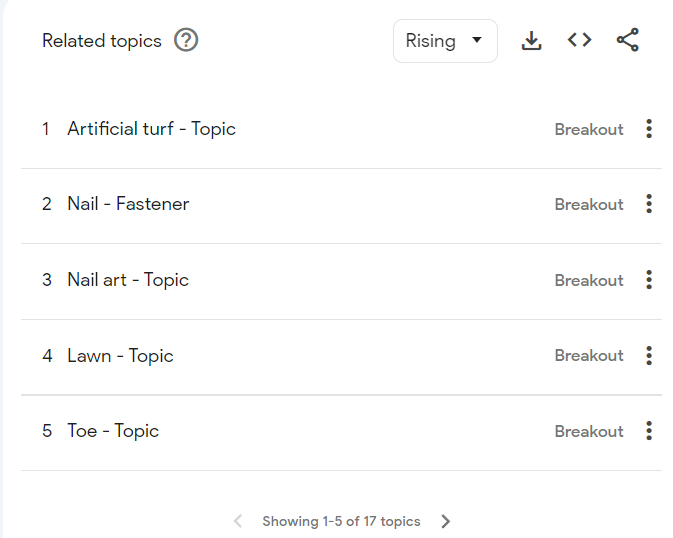
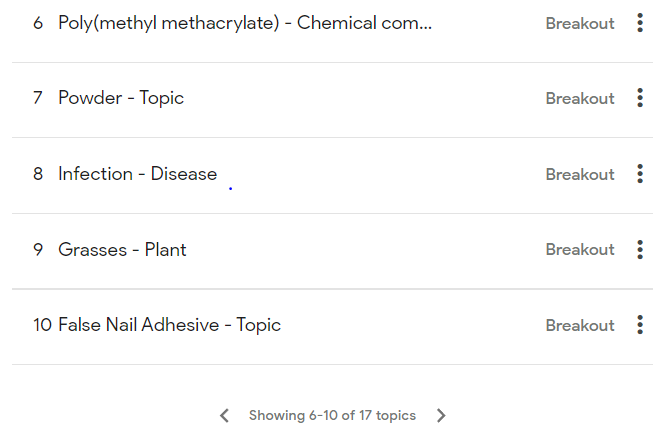
It’s intriguing how two of the examples — ‘Nail art’ and ‘Nail-Fastener’ — are associated with artificial nails and may be considered appropriate product categories for your store. Those who look for or use artificial nails are probably also attracted to these products.
So, looking at the related topics could be useful if you’re wanting to improve the product offerings on your site or shop. Since most artificial nails will need them, you might also sell ‘nail fasteners’ or ‘false nail adhesive’ in your shop.
Be aware that some of the related topics, such as ‘artificial turf’ or ‘lawn’, may not apply to your business when you read through some of the related ones. So, disregard the meaningless phrases.
3. Using Google Trends for Keyword Research
Here comes the most important part.
You might wonder, how to use Google Trends for keyword research.
Let’s assume your business sells men’s trousers. According to Google Trends, searches for this are trending higher, which is positive.

Now, however, you must decide which keywords to target, how to label your product categories, and even how to best optimise a blog article on men’s trousers. One simple approach you may do is to glance at ‘Related queries,’ which is located to the right of the section we just discussed called ‘Related topics.’
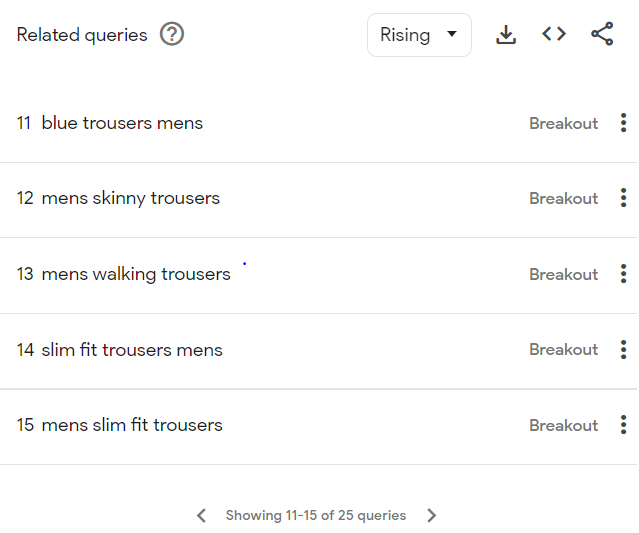
You may notice mentions of types and colours throughout all 25 queries. There is a listing for the colour blue in the image above.
You can find several styles and additional colours of trousers on additional queries. For these instances, you can decide to make a color-based product category called ‘blue trousers’ or styles like ‘waterproof’.
However, you may also include such keywords in the title of the product and on the product’s web page.
4. Using Google Trends to Understand Seasonal Trends
If you’re in e-commerce and dropshipping and are unsure how to use Google Trends for dropshipping, let me tell you that it’s quite useful for informing you of the seasonal patterns in your niche or for certain items.
Seasonal trends are crucial to the profitability of your company. There may be highs and lows throughout the year that will affect your monthly sales.
Sales and competition will both intensify throughout the busy season. When sales are declining, you may opt to start offering seasonal items. Here’s an example using a ‘winter’ item: ‘waterproof pants.’
Customers are aware of how pleasant waterproof clothing is during the rainy and snowy seasons. This winter product is in high demand because of this and is legitimately one of the necessities for the season.
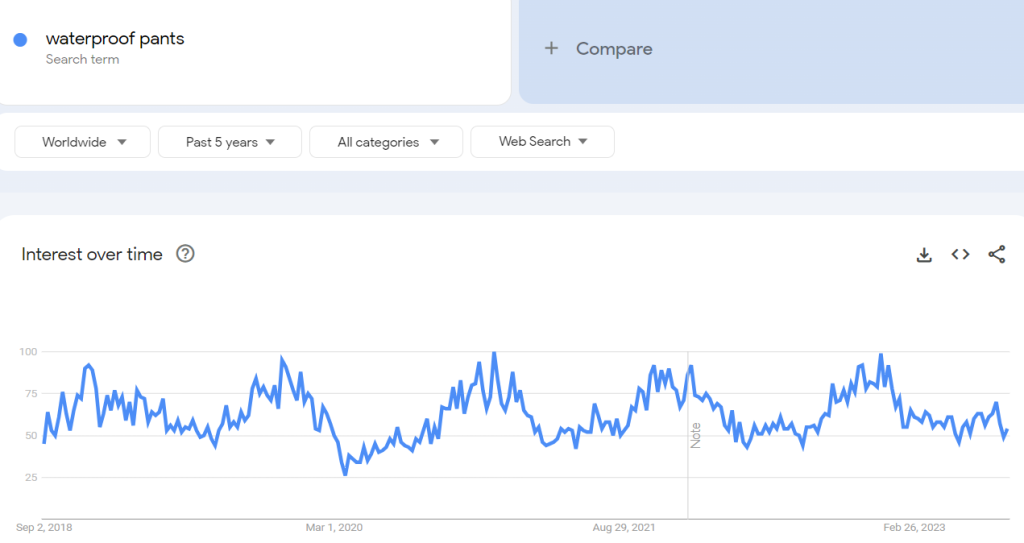
August marks the beginning of the year’s first peak, which rises through October. Then, in December, there is a slight decline. Now, let’s assume you decide to open a trouser shop in December.
You could be feeling fairly disheartened about that decline. However, that’s a fantastic moment to begin. It offers you a few months to develop your waterproof trousers business so that you are prepared when January comes around.
Since the jacket is often sold by many trouser brands, selling summer jackets throughout the summer can be a good area to concentrate.
Let’s have a look:
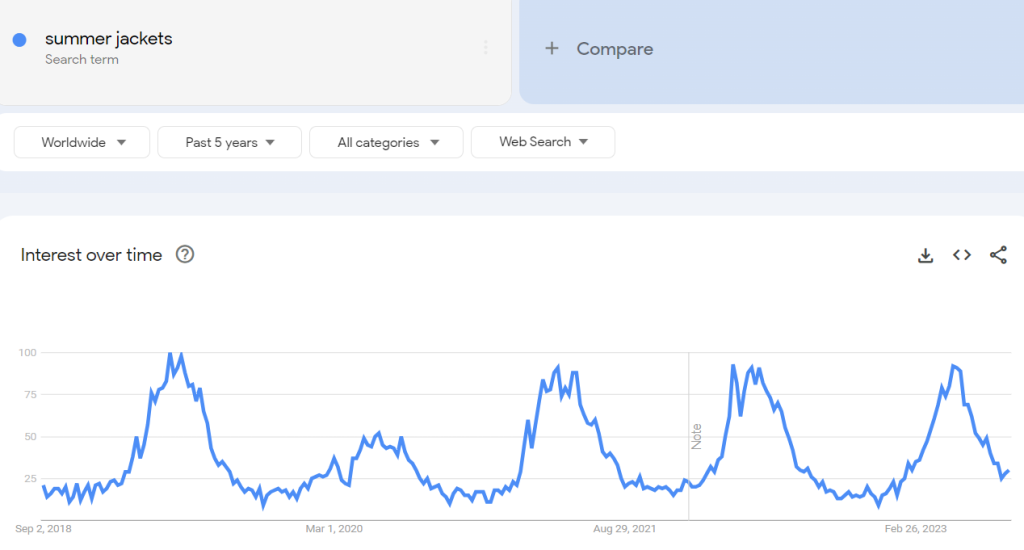
As you can see, summer jacket sales are at their highest from March to June, making them the perfect item to sell when waterproof trousers aren’t in demand.
5. Using Google Trends for Content Refurb
Leading online retailers are benefiting from content marketing as they drive more traffic, raise brand recognition, and attract more customers than before. Therefore, writing blog posts for your website might aid in the expansion of your company.
‘Content refurb’ is one strategy to generate sporadic increases in search traffic. So, you might think what is that? It happens when you update your blog’s content by adding fresh details, and any new keywords and removing any out-of-date material.
What role does Google Trends play here?
Let’s revisit seasonality but for a different cause this time. Now, suppose you operate a car repairing shop, and may have a blog post titled ‘How to Fix a Car Dent.’ If you enter those terms into Google Trends, it will appear as follows:
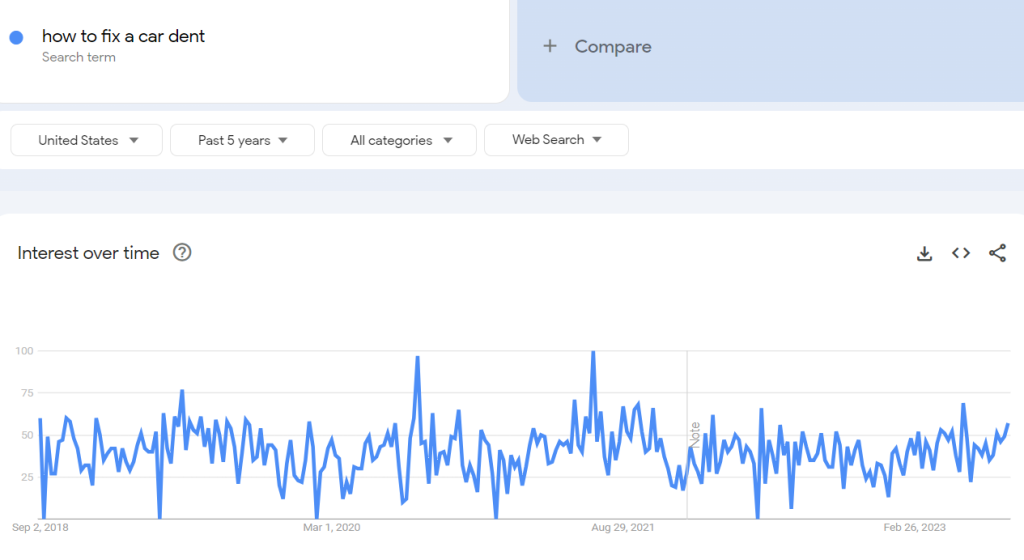
This demonstrates that May to July each year tends to be the peak season for this search. Naturally, once your ranking in Google starts to slip, you need to update your content. That is unavoidable. The peak season for the search keyword may also be used to time your content revamp if you really want to improve your game.
So, if you’re an owner of that dent repair shop, you might update the guide on ‘how to fix a car dent’ at the start of April or before. And if you do so, your ranking in the search engine results for that term will soar.
By using this technique for your best-performing SEO content, you may improve website traffic rapidly.
6. Using Google Trends to Create Content on Current Trends
There is a section devoted to trending searches on Google Trends’ home page. The trendiest subjects at the moment may be found in trending searches. You may search by country and explore daily trending searches as well as real-time search trends.
Although celebrity news predominates most trending searches, there are also hot topics related to certain niches. For instance, on August 23, 2023, the ‘ISRO,’ which received over 5 million searches, was the most popular daily trend. In the ‘Related news’ area, you may see terms like ‘Chandrayaan-3’ and ‘Chandrayaan 3 news.’
Now, you could have been able to write a noteworthy piece on the subject for your blog if you own a business or blog about science, technology, or engineering.
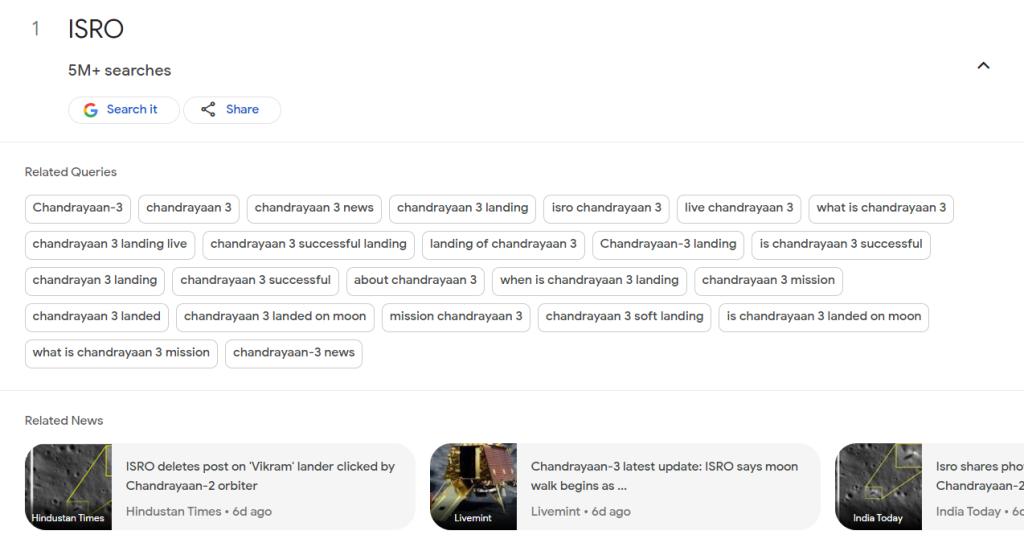
Currently, the iQOO Z7 Pro mobile’s launch is India’s second-most popular daily trend. You could decide to feature new mobile launch news regarding leading mobile manufacturers if you own a mobile and accessory store with an Indian consumer base.
Now, Why should you do that? because those who are curious about electrical or mobile gadget news could be interested in purchasing it. Additionally, you improve the efficiency of retargeting advertisements by attracting targeted viewers back to your website.
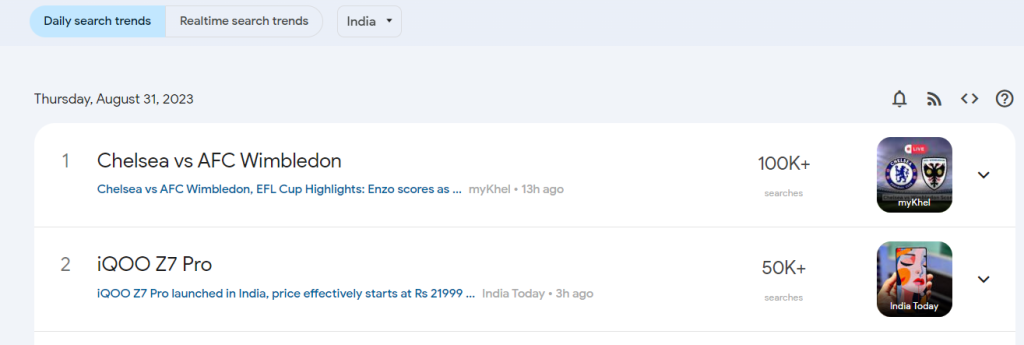
You may increase the number of visitors to your website by sometimes covering noteworthy items on the blog of your business. To increase the number of social media interactions and followers for your newsworthy content, you can also use trending hashtags on various social media platforms.
7. Using Google Trends to Find Niche Topics by Specific Location
Finding niche topics by area or location is one of Google Trends’ more intriguing features.
We frequently choose an audience for advertising depending on where they are. In India alone, there are 1.42 billion people. There is no doubt that the audience in West Bengal and Delhi are not the same.
Let’s examine how these two states feel about the ‘diamond ring’ now.
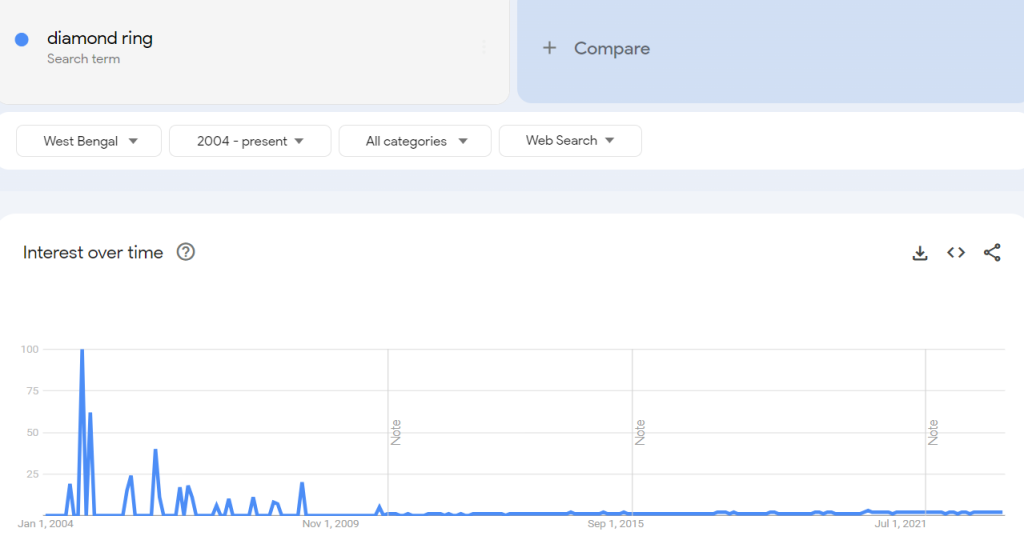
The demand for diamond rings is declining in West Bengal. The number of searches spiked in 2004, but over time, that level of interest has all but vanished.
Let’s look at the search interest for Delhi right now.
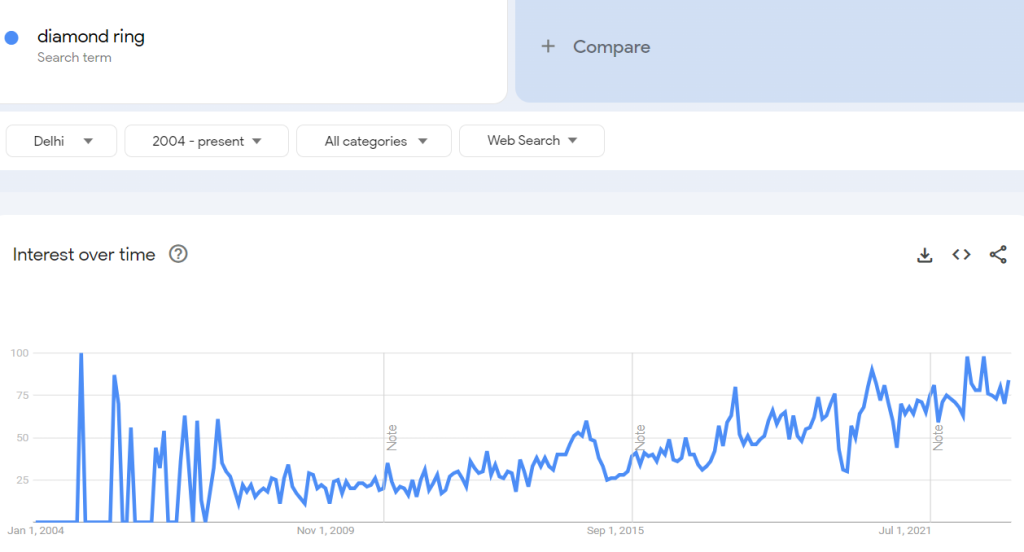
In Delhi, the number of searches for ‘diamond ring’ is currently increasing. What does this mean? You’d be better to focus on certain states like Delhi if you were making an advertisement for a diamond ring you were selling. You’ll be able to profit from some sales whether you advertise it on Facebook/Instagram or through Google Ads (Search or Display Ads) since there is rising demand there.
To find out which states have had the trend increase, cross-reference all the states.
By focusing on areas where interest is low, you boost your chances of making sales without spending too much money.
8. Using Google Trends to Perform Competitors Research
Google search trends might support your study of your competitors. You may keep an eye on your rivals to evaluate how they stack up against your brand.
Let’s compare the historical performance of the two rival companies, Apple and Microsoft Corporation.
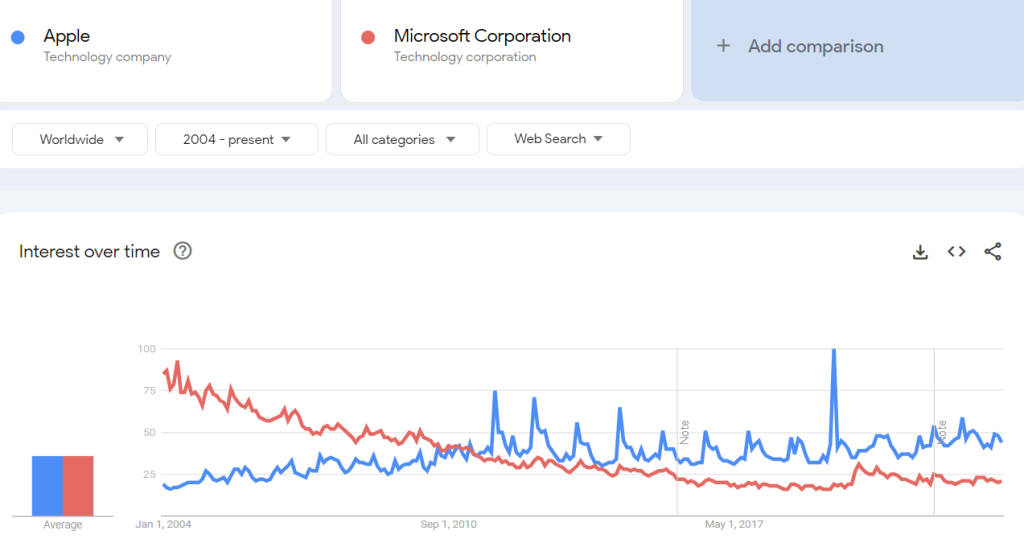
What’s notable about this is that, up until 2010, Microsoft performed far better than Apple. But beginning in 2010, we can clearly witness Apple’s ascent to the top and complete dominance.
You may compare up to five keyword searches or rivals with this function. As the search audience for your business expands, you may use Google Trends comparison to keep one step ahead of competitors.
And if you see that any of your rivals are expanding more quickly than you are, you’re probably going to start examining their marketing strategies to figure out how you might do better.
Undoubtedly, Google Trends is a powerful free tool for researching your market and competition.
Read More: 15 Top Marketing Metrics Everyone In Marketing Should Know
9. Using Google Trends to Improve YouTube Reach
Are you a YouTuber wondering about how to use Google Trends for YouTube and grow your reach?
Well! While Google Trends is frequently used to improve a website’s performance, you may additionally use it to increase your social media presence, notably on YouTube.
Popular YouTube topics are covered by Google Trends as well. ‘budget travel’ was the search term I chose here. Change the default category to ‘YouTube Search’ from ‘Web search.’ Additionally, you may change the category (in this instance, ‘Travel’) to reflect the topic of your channel.
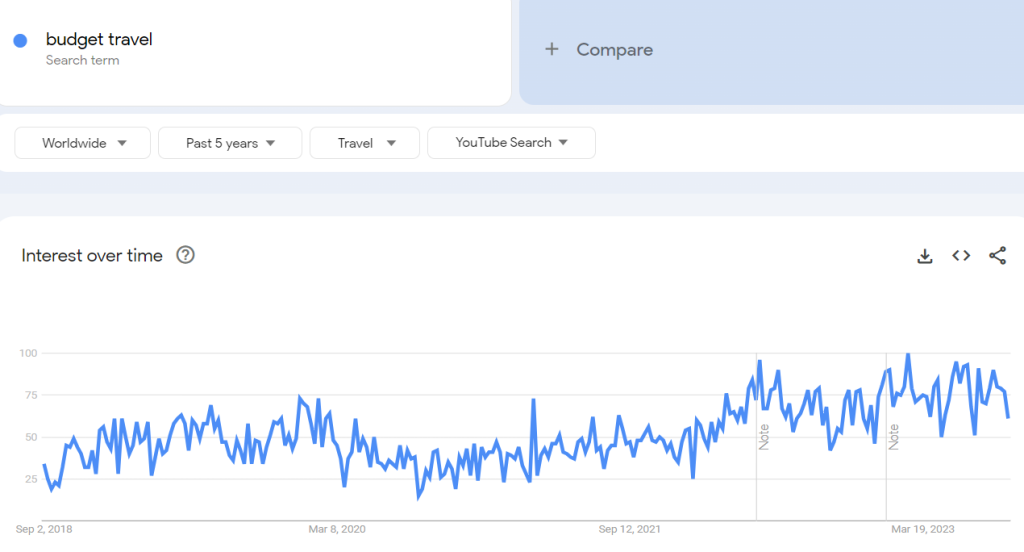
Start by examining the keyword’s overall trend to determine whether or not this topic is still popular. It appears that interest in budget travel is rising steadily.
To discover what subjects are now trending alongside what people are searching for, scroll down to ‘Related topics’ and ‘Related queries’:
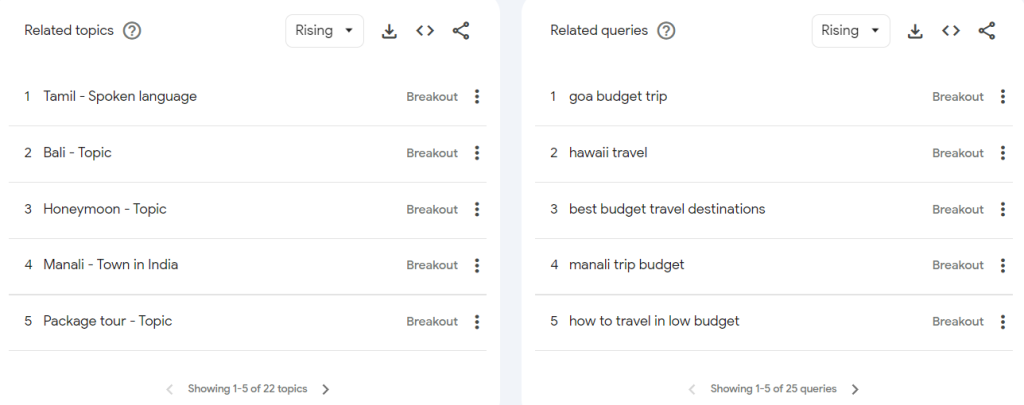
Here, the related topics are those that are linked. This might be an excellent opportunity to investigate your competitors to see what sorts of videos other channels are publishing on similar subjects.
You can get inspiration for those videos by using the related queries. Following are a few ideas of video concepts from the top five results:
- Goa budget trip
- Best budget travel destinations
- How to travel in low budget
10. Using Google Trends to Create Google Shopping Ads
You can also use Google Trends data to determine when to plan your Google Shopping ads.
Consider that you are a sports shoe brand trying to promote a brand-new sports shoe in your store. You can decide the best months for your Google Ads simply by entering a keyword and switching to the ‘Google Shopping’ feature from Google Trends’ ‘Web search’ feature.
Let’s look at the data below:
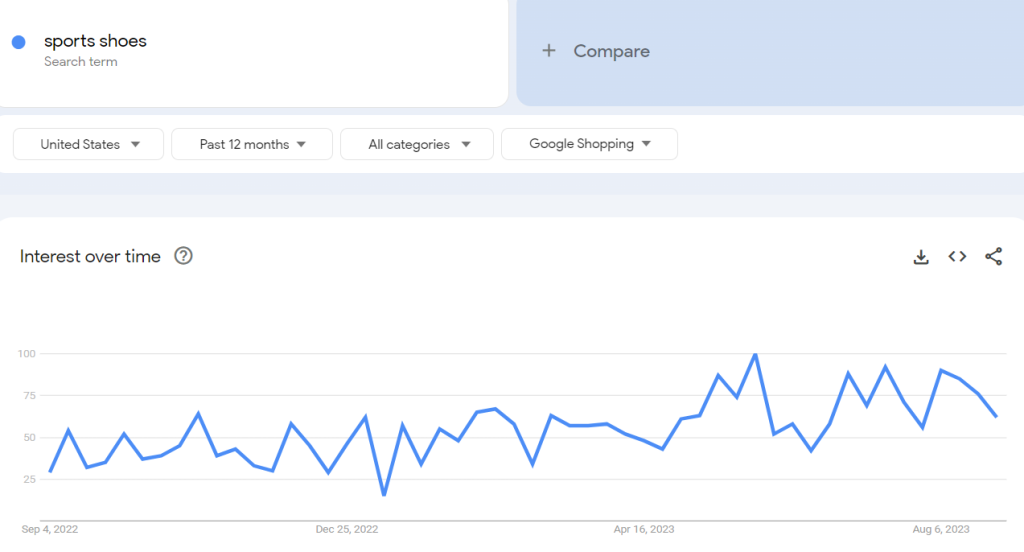
You can see that interest rises in the summer and falls in the autumn and winter. Running shopping advertising during that time period might offer you a jump start when things begin to pick up again in February. Additionally, it would be a good idea to show advertisements all summer long.
Well, providing you are marketing to Americans. You must separately evaluate the data for each country you wish to target in addition to the United States.
Frequently asked questions on how to use Google Trends
How to find niches on Google Trends?
Google Trends may be used in a variety of ways to identify niches. You are already aware of how the tool shows you how search interest in a specific term and related topics changes over time. These topics, both ‘Rising’ and ‘Top’ ones, might help you identify popular niches.
There are some markets that are only successful at specific seasons of the year. The seasonal fluctuations in popularity for a topic or keyword may also be used to determine this. To determine which niches perform most well in the market you are targeting and sector, you may further narrow your findings by ‘Region’ and ‘Category.’
What are the limitations of Google Trends?
Here are several areas where Google Trends lacks when it comes to capabilities. Data cannot be directly compared between nations because population size has not been taken into account. Data is based on sample searches and does not accurately reflect the entire population. Low search volumes make it impossible to provide accurate data for new product categories, low-frequency keywords, or small brands.
How to use Google Trends for SEO?
You may utilise Google Trends to look for topics that are currently popular or trending and then write blog posts optimized with related keywords to increase quality traffic and boost your SEO.
How to use Google Trends for market research?
Go to the explore part and select the appropriate category according to your requirements. Following that, you may choose a time frame and view trending topics for market research.
How to use Google Trends for eCommerce?
Google Trends may be a useful tool for e-commerce marketing since it allows you to observe customer demand in real-time. Trendy items may be reviewed before being effectively marketed with quality information.
How does Google Trends use social media marketing?
You may make social media content based on hot subjects and events that are currently trending. To increase your interaction, you may also seek for useful social media hashtags to increase impressions and followers in advance.
How accurate is Google Trends data?
Data for Google Trends is compiled from Google search trends, which provide an indication of search patterns in various geographical areas of the world. But this information is relative. This implies that it displays the proportion of searches for a particular keyword or query to all Google searches. So, when comparing keyword popularity and trending topics, it is often accurate.
Conclusion
Google Trends may provide you with information that can help your business succeed, from advising you on seasonal patterns to assisting you in identifying a fast-expanding niche.
There is a wealth of useful information in Google Trends that might support unconventional tactics. Experimenting is the greatest method to use data from organic search to find out more about your customers.
Try out many different words, topics, and comparisons. Use various eras, categories, and geographical scenarios. Watch out for popular searches. Be enquiring.
You’ll learn more crucial information about your target audience as you investigate deeper. Utilise the data to make sure your customers encounter your brand when they look for solutions to issues and new interests. To actually engage with them, be prepared with original content experiences.
By using most of the Google Trends tips in this article, you might be able to keep a couple of steps ahead of the competition. This is your chance to rule, so seize it!

